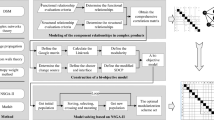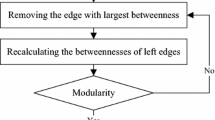Abstract
As a cost saving and profit-making strategy, a modular design is being employed in developing complex products and systems (CoPS) in recent decades. At the early stage of design, the reliability of a product can be improved by identifying the influential function modules based on the modular function architecture. In this study, the weighted LeaderRank algorithm and susceptible-infected-recovered (SIR) model of weighted and directed complex networks (WDCNs) are employed to identify the influential function modules of modular CoPS at the conceptual design stage. First, the structure of the function module is obtained and is mapped into a WDCN. Second, based on the similarity between the behaviors of nodes in the WDCN and function modules in the CoPS, a node-identification approach based on the weighted LeaderRank algorithm is employed to identify the influential function modules, whose influences are then verified through the SIR model. The influential function modules of a modular large tonnage crawler crane are determined as a case study to demonstrate the effectiveness and validity of the developed method.



















Similar content being viewed by others
References
Akritidis, L., Katsaros, D., & Bozanis, P. (2011). Identifying the productive and influential bloggers in a community. IEEE Transactions on Systems Man & Cybernetics Part C Applications & Reviews, 41(5), 759–764.
Alloui, I., Cîmpan, S., & Verjus, H. (2008). Towards software architecture physiology: Identifying vital components. In Seventh Working IEEE/IFIP Conference on WICSA, Software Architecture, 2008 (pp. 293–296). IEEE.
Bai, W. J., Zhou, T., & Wang, B. H. (2007). Immunization of susceptible-infected model on scale-free networks. Physica A Statistical Mechanics & Its Applications, 384(2), 656–662.
Brin, B. S., & Page, L. (1998). The anatomy of a large scale hypertextual web search engine. Computer Networks and ISDN Systems, 30(1), 107–117.
Browning, T. R. (2002). Applying the design structure matrix to system decomposition and integration problems: A review and new directions. IEEE Transactions on Engineering Management, 48(3), 292–306.
Chang, K. H., & Cheng, C. H. (2011). Evaluating the risk of failure using the fuzzy OWA and DEMATEL method. Journal of Intelligent Manufacturing, 22(2), 113–129.
Chen, D., Lü, L., Shang, M. S., Zhang, Y. C., & Zhou, T. (2012). Identifying influential nodes in complex networks. Physica A Statistical Mechanics & Its Applications, 391(4), 1777–1787.
Chen, D. B., Gao, H., Lü, L., & Zhou, T. (2013a). Identifying influential nodes in large-scale directed networks: The role of clustering. Plos One, 8(10), e77455.
Chen, L. H., & Ko, W. C. (2009). Fuzzy linear programming models for new product design using QFD with FMEA. Applied Mathematical Modelling, 33(2), 633–647.
Chen, W., Lakshmanan, L. V., & Castillo, C. (2013b). Information and influence propagation in social networks. Synthesis Lectures on Data Management, 5(4), 1–177.
Cheng, H., & Chu, X. (2012). A network-based assessment approach for change impacts on complex product. Journal of Intelligent Manufacturing, 23(4), 1419–1431.
Chiu, M. C., & Okudan, G. (2014). An investigation on the impact of product modularity level on supply chain performance metrics: An industrial case study. Journal of Intelligent Manufacturing, 25(1), 129–145.
Csermely, P., Korcsmáros, T., Kiss, H. J., London, G., & Nussinov, R. (2013). Structure and dynamics of molecular networks: A novel paradigm of drug discovery: A comprehensive review. Pharmacology & Therapeutics, 138(3), 333–408.
Fan, B., & Qi, G. (2007). Modeling of product family stricture and module analysis method based on complex network. Chinese Journal of Mechanical Engineering, 43(3), 187–186.
Feng, G., Cui, D., Wang, C., & Yu, J. (2009). Integrated data management in complex product collaborative design. Computers in Industry, 60(1), 48–63.
Fu, Y., Li, M., & Chen, F. (2012). Impact propagation and risk assessment of requirement changes for software development projects based on design structure matrix. International Journal of Project Management, 30(3), 363–373.
Gershenson, J. K., Prasad, G. J., & Zhang, Y. (2004). Product modularity: Measures and design methods. Journal of Engineering Design, 15(1), 33–51.
Guo, F., & Gershenson, J. K. (2007). Discovering relationships between modularity and cost. Journal of Intelligent Manufacturing, 18(1), 143–157.
Hansen, K. L., & Rush, H. (1998). Hotspots in complex product systems: Emerging issues in innovation management. Technovation, 18(9), 555–561.
Hobday, M., Rush, H., & Tidd, J. (2000). Innovation in complex products and system. Research Policy, 29(7–8), 793–804.
Holmqvist, T. K. P., & Persson, M. L. (2003). Analysis and improvement of product modularization methods: Their ability to deal with complex products. Systems Engineering, 6(3), 195–209.
Jose, A., & Tollenaere, M. (2005). Modular and platform methods for product family design: Literature analysis. Journal of Intelligent Manufacturing, 16(3), 371–390.
Karsak, E. E. (2004). Fuzzy multiple objective programming framework to prioritize design requirements in quality function deployment. Computers & Industrial Engineering, 47(2–3), 149–163.
Kim, Y., Son, S. W., & Jeong, H. (2010). Finding communities in directed networks. Physical Review E Statistical Nonlinear & Soft Matter Physics, 81(2), 95–102.
Langville, A. N., & Meyer, C. D. (2006). Google’s PageRank and beyond: The science of search engine rankings (Vol. 30, pp. 68–69). Princeton: Princeton University Press.
Lian, X., Yang, Y., & Wang, J. (2017). Research on complex product design change propagation based on complex networks. In International conference on industrial technology and management. IEEE.
Li, Q., Zhou, T., Lü, L., & Chen, D. (2013b). Identifying influential spreaders by weighted LeaderRank. Physica A Statistical Mechanics & Its Applications, 404(24), 47–55.
Li, Y., Chu, X., Chu, D., & Liu, Q. (2014). An integrated module partition approach for complex products and systems based on weighted complex networks. International Journal of Production Research, 52(15), 4608–4622.
Li, Y., Wang, Z., Zhang, L., Chu, X., & Xue, D. (2017). Function module partition for complex products and systems based on weighted and directed complex networks. Journal of Mechanical Design, 139(2), 021101.
Li, Z., Cheng, Z., Feng, Y., & Yang, J. (2013a). An integrated method for flexible platform modular architecture design. Journal of Engineering Design, 24(1), 1–20.
Liu, J., Xiong, Q., Shi, W., Shi, W., & Wang, K. (2016). Evaluating the importance of nodes in complex networks. Physica A Statistical Mechanics & Its Applications, 452, 209–219.
Lü, L., Chen, D., Ren, X. L., Zhang, Q. M., Zhang, Y. C., & Zhou, T. (2016). Vital nodes identification in complex networks. Physics Reports, 650, 1–63.
Lü, L., Zhang, Y. C., Chi, H. Y., & Tao, Z. (2011). Leaders in social networks, the delicious case. Plos One, 6(6), e21202.
Ma, H., Chu, X., Xue, D., & Chen, D. (2016). Identification of to-be-improved components for redesign of complex products and systems based on fuzzy QFD and FMEA. Journal of Intelligent Manufacturing. https://doi.org/10.1007/s10845-016-1269-z.
Meyer, C. D. (2000). Matrix analysis and applied linear algebra. Siam Review, 43(3), xxii,714.
Miller, R., Hobday, M., Leroux-Demers, T., & Olleros, X. (1995). Innovation in complex systems industries: The case of flight simulation. Industrial and Corporate Change, 4(2), 363–400.
Pahl, G., Beitz, W., Feldhusen, J., & Grote, K. H. (2007). Engineering design: A systematic approach. Berlin: Springer.
Pastorsatorras, R., & Vespignani, A. (2002). Immunization of complex networks. Physical Review E Statistical Nonlinear & Soft Matter Physics, 65(3 Pt 2A), 106–126.
Petermann, T., & De, l R. P. (2004). Role of clustering and gridlike ordering in epidemic spreading. Physical Review E Statistical Nonlinear & Soft Matter Physics, 69(2), 279–307.
Prencipe, A. (2000). Breadth and depth of technological capabilities in cops: The case of the aircraft engine control system. Research Policy, 29(7–8), 895–911.
Shin, J. H., Kiritsis, D., & Xirouchakis, P. (2015). Design modification supporting method based on product usage data in closed-loop PLM. International Journal of Computer Integrated Manufacturing, 28(6), 551–568.
Sosa, M. E., & Rowles, C. M. (2004). The misalignment of product architecture and organizational structure in complex product development. Management Science, 50(12), 1674–1689.
Stone, R. B., & Wood, K. L. (2000). Development of a functional basis for design. Journal of Mechanical Design, 122(4), 359–370.
Stone, R. B., Wood, K. L., & Crawford, R. H. (2000). A heuristic method for identifying modules for product architectures. Design Studies, 21(1), 5–31.
Tang, D., Zhu, R., Tang, J., Xu, R., & He, R. (2010). Product design knowledge management based on design structure matrix. Advanced Engineering Informatics, 24(2), 159–166.
Wang, Z., Zhao, Y., Xi, J., & Du, C. (2016). Fast ranking influential nodes in complex networks using a k-shell iteration factor. Physica A: Statistical Mechanics and its Applications, 461, 171–181.
Wu, D., Zhen, X., Fan, X., Hu, Y., & Zhu, H. (2012). A virtual environment for complex products collaborative assembly operation simulation. Journal of Intelligent Manufacturing, 23(3), 821–833.
Yang, R., Wang, B. H., Ren, J., Bai, W. J., Shi, Z. W., Wang, W. X., et al. (2006). Epidemic spreading on heterogeneous networks with identical infectivity. Physics Letters A, 364(3–4), 189–193.
Yan, H. B., & Ma, T. (2015). A group decision-making approach to uncertain quality function deployment based on fuzzy preference relation and fuzzy majority. European Journal of Operational Research, 241(3), 815–829.
Yassine, A., & Braha, D. (2003). Complex concurrent engineering and the design structure matrix method. Concurrent Engineering, 11(3), 165–176.
Zhang, W., Zhang, Q., & Karimi, H. (2013). Seeking the important nodes of complex networks in product R&D team based on fuzzy AHP and TOPSIS. Mathematical Problems in Engineering, 2013, 1–9.
Acknowledgements
This project was supported by the Fundamental Research Funds for the Central Universities (No. 2015QNA41).
Author information
Authors and Affiliations
Corresponding author
Rights and permissions
About this article
Cite this article
Li, Y., Wang, Z., Zhong, X. et al. Identification of influential function modules within complex products and systems based on weighted and directed complex networks. J Intell Manuf 30, 2375–2390 (2019). https://doi.org/10.1007/s10845-018-1396-9
Received:
Accepted:
Published:
Issue Date:
DOI: https://doi.org/10.1007/s10845-018-1396-9




